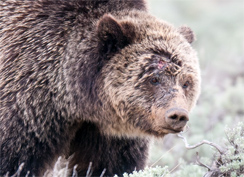Nature up close: Yellowstone's grizzly bears
By contributing "Sunday Morning" nature videographer Judy Lehmberg:
One of the few places in the lower 48 states where grizzly bears (a.k.a. North American brown bears) can still be found in healthy numbers is in the Yellowstone ecosystem. As we celebrate the 100th anniversary of our National Park system, changes may be coming to America's oldest national park, Yellowstone.
The U.S. Fish and Wildlife Service has recommended that Yellowstone's most iconic species, the grizzly bear, be removed as a threatened species under the Endangered Species Act, as grizzly bear populations have increased in recent years.
The grizzly female pictured above is known locally as "Obsidian Sow" because she lives on the west side of Yellowstone National Park in the area around Obsidian Cliffs. Her cubs were born during her winter hibernation. During that time she ate nothing, but successfully produced milk for the rapidly-growing cubs. By the time she came out of hibernation, she had lost about 40% of her body weight, and was ready to feed and regain her strength.
Grizzly bears are omnivorous. They eat a wide variety of food, from grass and dandelions to elk calves and army cutworm moths.
When the Obsidian Sow first came out of hibernation this year, she had three cubs. Shortly after she emerged, a male grizzly chased her and her cubs and killed one of them. Afterwards, the Obsidian Sow spent more time near the road and closer to people, presumably to help protect her remaining two cubs from the boar grizzly.
It is not uncommon for male grizzlies to kill newborn cubs. Killing the young promotes the female to stop lactating and resume ovulation, so the male has a better chance of fathering more young and passing his genes to the next generation. Some females show scars from defending their cubs from big males.
Many back country bears are never seen by humans; they associate roads with people, and stay away from them. Some bears in Yellowstone appear to know that, and stay closer to roads to gain protection from bigger bears. Females with cubs, especially, may resort to using the roads as a refuge.
Grizzly bears are creatures of the grasslands, and with fewer trees to climb, the best defense a mother bear can offer her cubs is a strong offense against male bears. Lewis and Clark found this out when they encountered their first grizzly bear on their journey of discovery -- a very different animal from the Eastern black bear with which they were familiar. A "most tremendous looking animal, and extremely hard to kill," wrote Lewis in his journal on May 5, 1805.
Travel Tip:
If you would like to see grizzlies with new cubs in Yellowstone, May and early June are the best times to visit.
Judy Lehmberg is a former college biology teacher who now shoots nature videos, using a RED Epic-X Dragon camera in ultra HD.
For more info:

